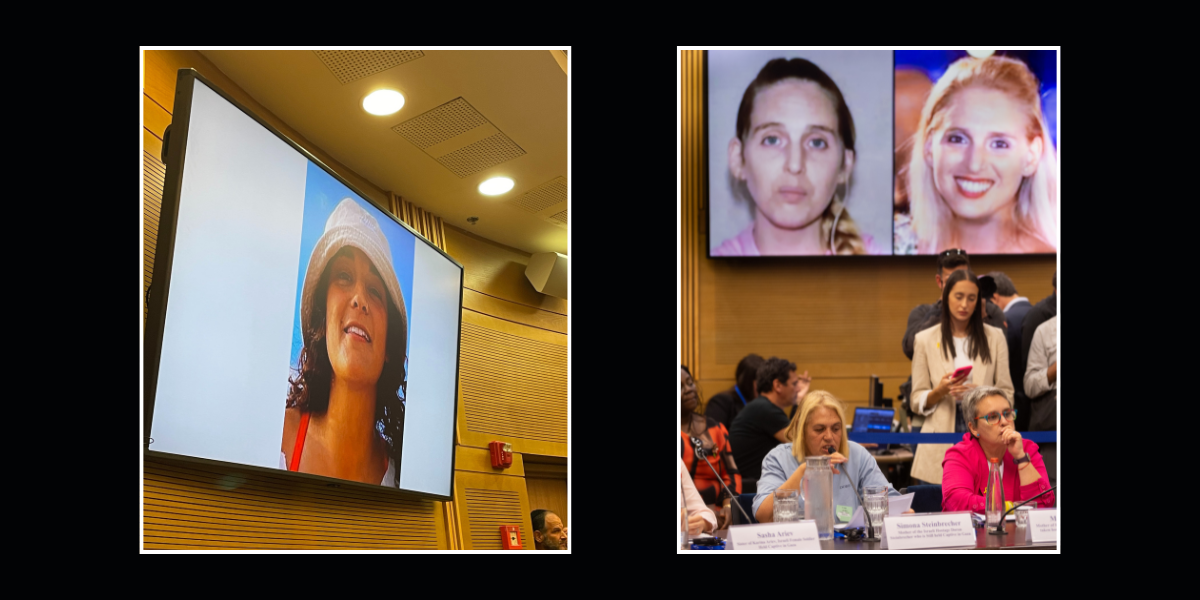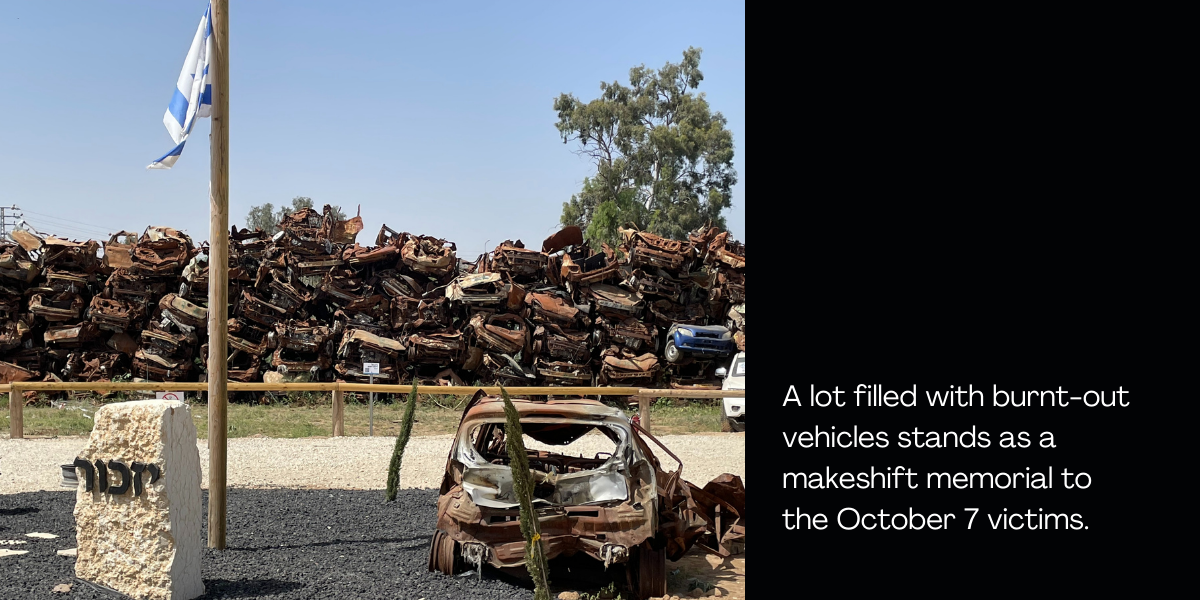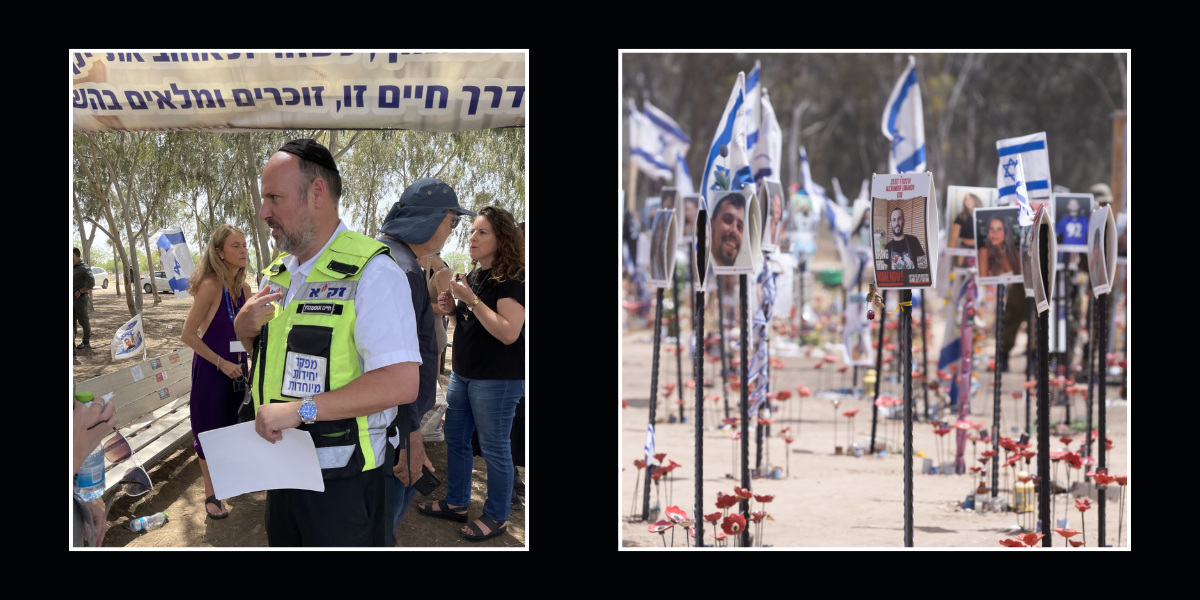Israeli Scene
October 7 Survivors Will Not Be Silenced

Nearly four months after going public with details of the sexual assault and abuse she experienced while being held hostage in Gaza, Amit Soussana is a long way from finding her path forward. “I can’t even begin to think about work,” she says. “I’m still hurt in so many ways.”
Tali Biner, who survived the massacre at the Nova musical festival on October 7, also is figuring out what’s next for her. She isn’t ready to return to the hospital where she worked as a nurse. “Unfortunately, I don’t feel that I’m healthy enough to treat people in Israel,” she says, noting that as a medical professional, she would be required to tend to all patients, regardless of their background.
Instead, Biner, also a singer/songwriter, is focusing on her music and speaking out about what she saw and heard while being holed up in a trailer for seven hours, with the sounds of death and sexual violence all around her.
Soussana and Biner are two of the many Israelis whose voices will not be silenced. They, like most in Israel, are perplexed, frustrated and angry that so much of the world is denying, downplaying or even justifying the atrocities that happened on October 7, when Hamas infiltrated the country, murdered 1,200 people, brutalized scores more and kidnapped some 250 individuals.
Among other voices that refuse to be silenced: family members of those still captive in Gaza; first responders who were the earliest eyewitnesses to the brutality inflicted by the terrorists; Israel Defense Forces soldiers who battled and continue to battle the terrorists; released hostages recovering from serious injuries; and those tasked with the sacred work of preparing for burial casualties of Israel’s longest war since the War of Independence.

I met face-to-face with Soussana, Biner and a few dozen other warriors and witnesses while in Israel for a week at the end of May. I was part of a delegation called I Believe Israeli Women, which was initiated and sponsored by the Seed the Dream Foundation in partnership with Jewish Women International.
I was representing Hadassah and Hadassah Magazine among a dynamic group of women—lawyers, judges, entertainment executives, journalists, philanthropists and professionals working on gender-based violence issues and at women-centered organizations—all determined to do just what Israelis are asking: amplify their stories; raise awareness about Hamas’s barbarism, particularly the sexual violence, and the need for accountability; and demand that the world take action to ensure that sexual violence as a weapon of war will not be tolerated.
READ MORE:
Fighting to Hold Hamas Accountable
Film Bears Witness to Hamas’s Sexual Violence
A Catholic Ally
Where are these survivors, soldiers and former hostages today? How are they navigating life now, nine months after that fateful day that changed the Jewish nation forever? Here are just a few of their stories, ones that reflect the horror as well as the heroism that continues to pervade every corner of Israeli society.

Amit Soussana dismisses the notion that she was courageous for being the first woman to publicly detail her tortured captivity. She says she had decided while still being held in Gaza that if she was released, she would tell her story of being assaulted and repeatedly beaten by her Hamas captors.
“It would make it less horrible for me,” the 40-year-old recalls thinking.
Her experience, which includes being chained to a wall by her ankles, repeatedly asked about her menstrual cycle, allowed virtually no privacy and forced to perform a sexual act on her guard, was reported in The New York Times on March 26.
But the horror and psychological impact persist.
Soussana was released November 30 in a hostage-prisoner exchange and ceasefire deal with Hamas. Over time, she has slowly regained her ability to show emotion, she told us in a meeting room of the Tel Aviv headquarters of the Hostages Families Forum, the volunteer-run nonprofit that advocates for the hostages and provides a host of services for their families.
“I couldn’t cry for two months after my release. I was happy, but I couldn’t show it,” Soussana said. A therapist she continues to see, she added, has helped her connect with her emotions.
In contrast, her mother, Mira, seems to have no problem expressing her emotions as she sits next to her daughter, repeatedly wiping away tears and reaching for Amit’s hand as she once again listens to the nightmarish details of what she experienced.
“My mom writes to me every night, says how much she loves me,” Soussana said with a smile.
As she recalls the torture and sexual abuse she experienced, she worries incessantly about those still being held. “It’s unimaginable what condition they’re in after 200-plus days,” she said.
Soussana thinks about returning to the law—she had been a practicing patent attorney—perhaps as a human rights attorney. But she can’t get out of her mind the way she was mocked by her captors for being a lawyer.
“When I told Hamas I was a lawyer, they would humiliate me,” she said. She described how they would make her clean while taunting her, saying, “ ‘What a good job the lawyer is doing.’ ”
She also thinks about returning to Kfar Aza, the border community where she had lived only for a year, having grown up in Sderot. It was a “beautiful kibbutz full of nature with amazing people,” she said. “It was the most wonderful year of my life.”

The section of Kfar Aza where Soussana lived lies in ruins. The whole kibbutz is eerily quiet, except for clusters of workmen tasked with clearing out the houses so rebuilding can begin.
The blood and smell of death is gone, but the devastation remains in the community that, before October 7, had 960 residents. Not all were in the kibbutz on that fateful day because it was a holiday, said reservist Ron, a captain in the IDF Spokesperson Unit, who does not give her last name in accordance with IDF protocol. Of those who were on the kibbutz, 64 were murdered and 19 were kidnapped.
Only one couple has returned to their home so far, along with a new first responder team charged with protecting the kibbutz, from which you can clearly see Gaza just about a mile away. On October 7, Kfar Aza had 14 members on the team. Seven of them were murdered and five were severely injured.
Soussana’s rental home on Kfar Aza was in the section of the kibbutz closest to the border with Gaza. At the end of the row of houses in this area stands the charred home of Sivan Elkabets and her fiancé, Naor Hasidim, both of whom were murdered during the attack. Inside, Elkabets’s mother has set up a little memorial to the couple, with photos and artwork along with a guest book at the entrance. The walls are sprayed with dozens of bullet holes. Outside, mundane remnants of their lives are still strewn about these many months later—an electric toothbrush, a chair cushion, a bra.
Banners with the photos and the names of the kibbutz’s five members still held captive in Gaza are hung everywhere.

Among those pictured is Emily Damari, who turned 28 while in captivity. Her mother, Mandy, was also a resident of Kfar Aza. On October 7, she was rescued by one of her sons who had just moved to Sderot. He was also able to reach his brother and his brother’s family on the kibbutz. Incessant shooting by the terrorists around Emily’s home prevented him from getting to her.
Today, like many of the hostages’ relatives, Mandy Damari spends many days in meetings, sometimes traveling around the world, begging for action that will lead to her daughter’s release.
Initially, Damari didn’t know whether her daughter had been murdered or taken hostage. As she waited for news, she recalled, she honestly didn’t know which she feared most, she told us in a session at the Hostages Families Forum building.
Eleven days after October 7, the family finally got word from the IDF that they had evidence that Emily had been taken hostage.
Damari’s hopes for her daughter’s return were raised when some of the hostages were released in the deal made in November. Someone in the first group released by Hamas reported that Emily was O.K., that she had been shot, but it was not life threatening and she had had some sort of surgery. The second group of hostages that soon followed had just been with Emily, Damari found out. Her daughter was apparently so certain she would be released soon that she didn’t give them a letter to take home.
At that point, Damari said, “at least I knew that she was alive. She and I were both certain she would be coming home,” as the authorities talked about releasing all the female civilians in the next hostage deal being discussed at the time. It didn’t happen.

At a huge, dusty, fenced-in field, an IDF reservist named Adam gives a tour of what has become the repository of 1,650 burnt-out vehicles caught in the maelstrom of the Hamas attack. Along one edge of the lot, several hundred are stacked in piles—cars, trucks, even ambulances that Hamas intentionally set on fire, often with people inside them.
“Each and every car has a story to tell,” Adam said. Many of the stories are told, he said, through the ashes that were painstakingly accumulated by 35 reservists from the IDF’s Military Rabbinate corps, which is in part responsible for identifying remains of soldiers and whose members worked around the clock clearing some 300 burned vehicles.
Among the vehicles brought to the lot, which has become a makeshift memorial of sorts, is the white trailer in which Tali Biner spent seven hours hiding with three friends on the site of the Nova music festival.
“All the atrocities, all the sexual abuse, all the things that you’ve heard of, sometimes I feel ashamed that I am carrying this weight on my chest, but I was a witness to those things,” she told our group, standing by the destroyed vehicles.
“I remember the sexual abuse that started in the area—from many sides, it surrounded me. I could hear women yelling for minutes and minutes. As a woman, it was clear to me what was happening. It always stopped with gunshots.
“I heard one couple; the man was begging for mercy for the woman. That, too, ended in silence.”
When she emerged from her trailer at about 3 p.m., she witnessed women with ripped shirts, spread legs, some without underpants; one woman was bound to a tree, her hands behind her back.

A surgical nurse at Ichilov Hospital in Tel Aviv before October 7, Biner quickly moved to do what she could to help the injured. Most of the people she saw were already dead.
Today, the 20-year-old Biner is spending her time “spreading word of what happened to us,” she said. She is also working on her music. She was speaking to groups in the United States earlier in the year when protesters at the University of California, Los Angeles prevented her from talking at a college forum.
More recently, in late May, soon after our visit, she met in Israel with Nikki Haley, a former governor of South Carolina and United States ambassador to the United Nations, who posted a photo of the two of them to social media.
Biner said she is also finding comfort being with other Nova survivors, some of whom come together as a community once a week. It was not easy at first. “I don’t feel comfortable getting the stamp of ‘survivor,’ ” she said. “It’s not fun to feel that you are doomed for life. But we are a family. We understand each other much better than other people will ever be able to understand.”

The site of the Nova music festival near Kibbutz Reim has been transformed into a vast memorial to the more than 360 individuals who were massacred there beginning at dawn on October 7. Banners with heartbreaking images of young men and women killed in the prime of their lives flap atop rows and rows of poles.
Speaking to us at the memorial site and sharing gruesome photos he had taken with his phone, Chaim Otmazgin, 50, one of the first responders from the ZAKA volunteer search and rescue group to arrive at the scene that day, grimly describes some of the horrors he discovered: naked bodies; women with blood and signs of abuse in the groin area; and, like Biner, describes seeing women tied up against the trunk of trees, naked, their legs spread apart.
Although it’s becoming increasingly difficult for him and he has cut back on his meetings with visitors, Otmazgin said he still forces himself to share the horrific stories and photos because he has the responsibility to do so as an eyewitness. “I promised the bodies that I would be the mouthpiece for them for what they couldn’t tell and what they can’t share.”

Shari Mendes has been spending a lot of time bearing witness to the atrocities she encountered after the October 7 attacks, though she has cut back a bit due to the psychological toll that it’s been taking on her.
As a reservist in the army unit that ritually prepares female soldiers for burial, Mendes saw firsthand the mutilation of some of the bodies she was preparing. Soon after the Israel-Hamas war began, she, an architect by profession, became one of the key figures giving testimony around the world about what she had found.
Speaking to us at Shura, the IDF base that is run by the Military Rabbinate, Mendes, 63, described what she called “the holy work” performed there. The base’s morgue is typically used for soldiers killed during their service and brought for burial preparation. But a decision was made after the October 7 attacks that all casualties—military and civilian—would be brought to Shura.
In the days following the massacre, truckloads of body bags were sent to the base, filling the cavernous space from floor to ceiling. Those working there never knew what kind of atrocity would be discovered inside each bag, Mendes recalled. Some of the women had no clothing; others, bloody underwear.
Only in retrospect did it become clear that there was a pattern to what they were finding, she said: blood in the genital areas, bullet wounds in sensitive areas and mass evidence of shooting in faces.
Despite the gruesome nature of the work and the pressure to identify the bodies quickly and prepare them for burial, Mendes said she found strength remembering the story of her grandmother’s brother. At the age of 20, he was in Auschwitz, tasked by the Nazis with taking bodies out of the ovens. According to family lore, Mendes said, her great uncle participated in a failed uprising attempt aimed at destroying the crematoria. “If he could do that, which was even worse, then I could do this,” she said.
She expressed deep frustration at the denialism that she has encountered, both personal attacks on her and in general. “Part of what is so sad about this experience to me is that there is an expectation that people who are raped should say, ‘Hi, I was raped’ in a world that doesn’t believe them.”
Some deniers in the media, including on social media, have suggested that the scenes of violence that Hamas terrorists themselves recorded and posted were AI-generated.
“Eyewitness testimony needs to be enough; it’s enough in other instances,” including regarding the Holocaust, Mendes said. “There’s an entire industry focused on denying me, and I’m nobody. There are evil people who are working 24/7 to take it all apart.”
“I don’t know how you fight that,” she added. “You just don’t. You just don’t give it credence.” Instead, you persevere, said Mendes, who is also a breast cancer survivor who founded the Lemonade Fund, which provides emergency grants to breast cancer patients—a need, she said, that has increased in the wake of October 7 due to increased financial pressures on families.
As Mendes said in the Sheryl Sandberg-presented Screams Before Silence, a documentary about the sexual violence that Hamas perpetrated: “We may never know the extent of the sexual violence because these women were silenced.”
“So, every one of us, women and men, must speak up for these women and say we will bear your story, we will bear witness for you. You will not be forgotten and what happened to you will be told.”
Lisa Hostein, executive editor of Hadassah Magazine, was part of the I Believe Israeli Women delegation, sponsored by the Seed the Dream Foundation in partnership with Jewish Women International.









 Facebook
Facebook Instagram
Instagram Twitter
Twitter
Leave a Reply